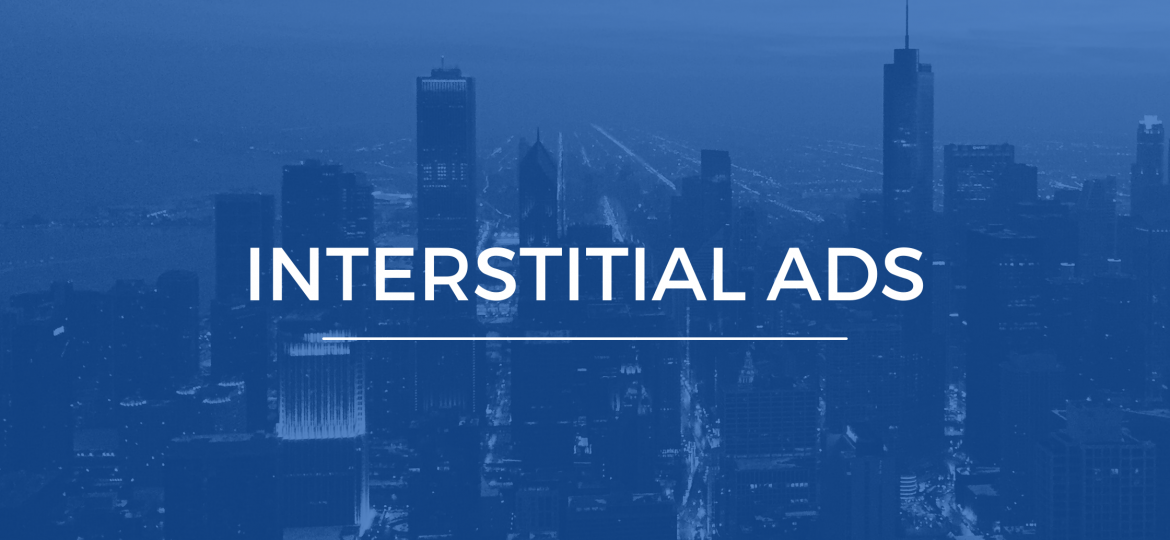Interstitial Ads have grown in popularity over the years to become accepted as a format on both mobile and traditional web experiences. In the beginning, there were banner ads and pop-up ads. Pop-up ads broke up the user experience and were phased out through technical means such as pop-up blockers. Over the years, through the growth and innovation in ad formats through mobile, native, and video advertising, pop-up Ads have evolved into a more accepted Interstitial Ad. In fact, Google launched Web Interstitial Ads in late 2020. In this piece, we will go into a bit more detail. What is an interstitial ad? Interstitial Ads are typically full-screen ads that cover the majority of the active screen, whether that is floating over a web page in view or filling the screen on a mobile device. As the name suggests, these ads appear in-between the content a user is engaging with. Good examples of such ads would be breaks in play, between levels in a game, at natural transition points within an app, or in-between pageviews, before accessing a new page or piece of content. Usually, the initiation happens on a specified action, whether that is the user clicks on a relevant link or reaches a designated point of action within an app or game. A required function of this format is the ability to close it and continue using the web page or app. This is usually in the form of an X in the top right corner or just…
Jeevan Pathare
Google AdSense and Google AdExchange (AdX) are both advertising services operated by Google. They allow publishers to make money by running advertisements. So, what is the difference between Google AdX and AdSense? Which platform would be best for you to offer your ad inventory on? In this post, we’ll go over the key features and discrepancies between Google AdX and AdSense. What is Google AdSense? Google AdSense was created as an internal product in 2003. It is a free cost-per-click tool that places ads on websites based on the content and visitors of the publisher. All that enables publishers to benefit from each ad click. Besides that, since CPM (cost per 1000 impressions) is in demand, publishers can receive extra revenue each time a CPM ad is served to the website and seen by a user. Technically speaking, advertisers bid for ad placement in the same way as they do on the Google Ads platform. AdSense advertisements are derived from Google Ads, the Google Display Network, and other Google products. Any publisher can use it because of the simple sign-up process. One of the best features of AdSense is that it instantly connects publishers with a large number of advertisers. This is the most famous advertisement software on the Internet at the moment. It offers an excellent opportunity for webmasters and content creators to monetize their traffic — Google pays billions to its publishers per year. If you’ve ever wondered, how can you make money with AdSense – just try…
Website monetization starts and ends with Google for many publishers, be it Google Ad Manager or Google AdSense. The difference between the two is the publisher’s level of sophistication to manage multiple demand sources. The vast majority of publishers, therefore, rely on Google AdSense to deliver many of the ads you see on blogs and independent niche websites. That means Link Ad Units appearing amongst the usual display ads.
These days there is so much information at our disposal, with metrics for almost everything. Sometimes, there are some metrics that do not just show a picture but also tell a story. For example, for Students, your GPA (Grade Point Average) shows how good a student you are, for growing businesses your CAC (Customer Acquisition Cost) shows you how much it costs to gain a new customer and grow your business. For Publishers like you, there is Page RPM. What is Page RPM? Page RPM refers to the revenue a publisher would expect to see generated per one thousand page views. RPM is an acronym for Revenue Per Mille, with Mille being the Latin word for a thousand (for those of you thinking back to college that’s why Roman numerals have M for a thousand!). RPM tells a publisher how much revenue is being generated for each page that is viewed on their website. A publisher can even calculate the Page RPM for individual pages. How do you calculate it? Before you can calculate Page RPM, you need to know 2 numbers; Total Ad Revenue – how much ad revenue you think you have made Total Page Views – how many times a user views a page The formula used is as follows: Total Ad Revenue / Total Page Views * 1000 Example: If you have 4k page views per month and an estimated ad revenue of $30, your Page RPM would be ($30/4000)*1000 = $7.50 Why it is Important?…
Google Chrome is the dominant web browser in the world with a 65% market share against the next best Apple Safari at 16%. Google‘s idea was to build a web browser that was fast and responsive with the best user experience possible. So it is with this in mind along with the Better Ads Standards, that Google has added a default setting live from late August to block ‘Heavy Ads’.
Ever since GDPR (General Data Protection Regulation) revolutionized the conversations of everyone with digital advertising interests in the EU, companies in the US have had to make a decision. Withdraw from the EU, make preparations to be compliant, or follow suit and apply a similar standard in the US. CCPA is California’s approach to privacy and consumer data. With the industry evolving at its rapid rate and the introduction to new systems and processes, there is a need in the industry for regulations that enforce best practices. Privacy and how consumer data is currently being processed within different parties has become one of the biggest concerns, especially since the Cambridge Analytica scandal. In this article, you will learn more about what CCPA is, how it works, who it applies to, and what you may need to do in order to be compliant.
“Ad quality is in my top three concerns as a publisher.” How many times do we hear this? Almost always? This has always been a topic of interest. But especially in the current situation, it has been accentuated since there is a gap between supply and demand for inventory. Advertiser buying and spending patterns have changed leading to publishers taking some drastic measures to earn a sustainable revenue. It’s a vicious cycle, dropping floor prices or increasing the available inventory opens the door to another larger problem – Bad ads/ Ad Quality. This should be a concern as it can have serious implications on the business model as a whole. So here is why maintaining top tier ad quality is always a good idea.
In these uncertain times, Google made its stance on third-party cookies very clear. The announcement was made in February 2020 to phase out the use of third-party cookies within the Chrome browser by 2022. This brings Google Chrome, by far the world’s most popular internet browser used by about 63% of internet users across mobile and desktop, up to speed with Apple Safari and Mozilla Firefox, which represent about 19%. After both GDPR and CCPA forced publishers to rethink consent, the cookie is now a key issue. Privacy concerns have been the biggest driver for change within the industry, now the battle is around anonymity and what that really means. To clarify, the commodity here is internet users’ cookie IDs. Let’s look at what the future of the cookie looks like and what this means for publishers and advertisers.
In this piece, we’ll be talking about sticky ads. A sticky ad, which you might have already guessed, is an ad that sticks to a web page. If you implement a sticky ad into your website and a user scrolls down the page, the sticky ad will remain on the users’ screen.










